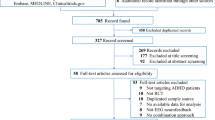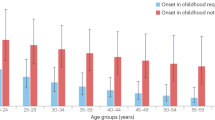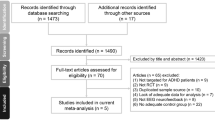Similar content being viewed by others
The Editor-in-Chief has retracted this article due to concerns regarding the analysis of the articles included in the meta-analysis. Specifically: (1) The authors’ overall allocation of Risk of Bias (ROB) was not in line with Cochrane guidance. (2) Frei et al. 2005 has no bias stated in the authors’ raw data, but the study only included “responders” (children were treated with homeopathy in the screening phase, and only those who showed improvement were selected for the trial). This should be considered “other bias”. (3) The results of Jacobs et al. appear to be misrepresented, as their study demonstrated higher improvement in the main outcome in the control group compared with the homeopathy group (CGI-P T-score 9.1 vs. 4.1), while the current study reported these results to be in favour of homeopathy. (4) Oberai et al. [1] reported effect sizes for their three main outcomes of 0.22, 0.59 and 0.54 (Revised Conners’ Parent Rating Scale [CPRS-R], Clinical Global Impression-Severity Scale [CGISS], Clinical Global Impression- Improvement Scale [CGIIS]) respectively however in this article 1.436 was given as the average effect size. The authors do not indicate if they recalculated effect sizes from the data in the study. Based on the above deficiencies following thorough review, the Editor-in-Chief has substantial concerns regarding the validity of the results presented in this article.
K. Gartner disagrees with the retraction; M. Teut and H. Walach agree with the retraction.
1. Oberai, P. et al. Homoeopathic management of attention deficit hyperactivity disorder: a randomised placebo-controlled pilot trial. Indian J. Res. Homoeopathy 7, 158–167 (2013).
The online version of this article contains the full text of the retracted article as Supplementary Information.
Change history
20 September 2023
This article was retracted on 20 September 2023.
Author information
Authors and Affiliations
Corresponding author
Additional information
The Editor-in-Chief has retracted this article due to concerns regarding the analysis of the articles included in the meta-analysis. Specifically: (1) The authors’ overall allocation of Risk of Bias (ROB) was not in line with Cochrane guidance. (2) Frei et al 2005 has no bias stated in the authors’ raw data, but the study only included “responders” (children were treated with homeopathy in the screening phase, and only those who showed improvement were selected for the trial). This should be considered “other bias”. (3) The results of Jacobs et al. appear to be misrepresented, as their study demonstrated higher improvement in the main outcome in the control group compared with the homeopathy group (CGI-P T-score 9.1 vs. 4.1), while the current study reported these results to be in favour of homeopathy. (4) Oberai et al. [1] reported effect sizes for their three main outcomes of 0.22, 0.59 and 0.54 (Revised Conners’ Parent Rating Scale [CPRS-R], Clinical Global Impression-Severity Scale [CGISS], Clinical Global Impression- Improvement Scale [CGIIS]) respectively however in this article 1.436 was given as the average effect size. The authors do not indicate if they recalculated effect sizes from the data in the study. Based on the above deficiencies following thorough review, the Editor-in-Chief has substantial concerns regarding the validity of the results presented in this article.
Supplementary information
Rights and permissions
Open Access This article is licensed under a Creative Commons Attribution 4.0 International License, which permits use, sharing, adaptation, distribution and reproduction in any medium or format, as long as you give appropriate credit to the original author(s) and the source, provide a link to the Creative Commons license, and indicate if changes were made. The images or other third party material in this article are included in the article’s Creative Commons license, unless indicated otherwise in a credit line to the material. If material is not included in the article’s Creative Commons license and your intended use is not permitted by statutory regulation or exceeds the permitted use, you will need to obtain permission directly from the copyright holder. To view a copy of this license, visit http://creativecommons.org/licenses/by/4.0/.
About this article
Cite this article
Gaertner, K., Teut, M. & Walach, H. RETRACTED ARTICLE: Is homeopathy effective for attention deficit and hyperactivity disorder? A meta-analysis. Pediatr Res (2022). https://doi.org/10.1038/s41390-022-02127-3
Received:
Revised:
Accepted:
Published:
DOI: https://doi.org/10.1038/s41390-022-02127-3
This article is cited by
-
Use of complementary and alternative medicine in children affected by oncologic, neurologic and liver diseases: a narrative review
Italian Journal of Pediatrics (2023)
-
Plädoyer für eine objektive Prüfung der vorliegenden Evidenz zur Homöopathie bei rheumatischen Erkrankungen
Zeitschrift für Rheumatologie (2023)
-
Rheumatologie und Homöopathie – eine kritische Diskussion
Zeitschrift für Rheumatologie (2023)



